
“It’s better to look ahead and prepare, than to look back and regret.”
-Jackie Joyner-Kersee
Jobs Update
- Initial jobless claims for the week ending December 3rd, 2022 came in at 230,000, up 4,000 people week-over-week.
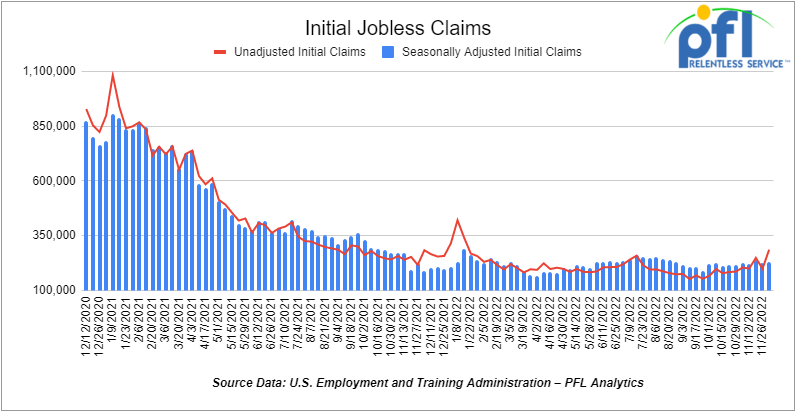
- Continuing jobless claims came in at 1.671 million people, versus the adjusted number of 1.609 million people from the week prior, up +62,000 people week over week.
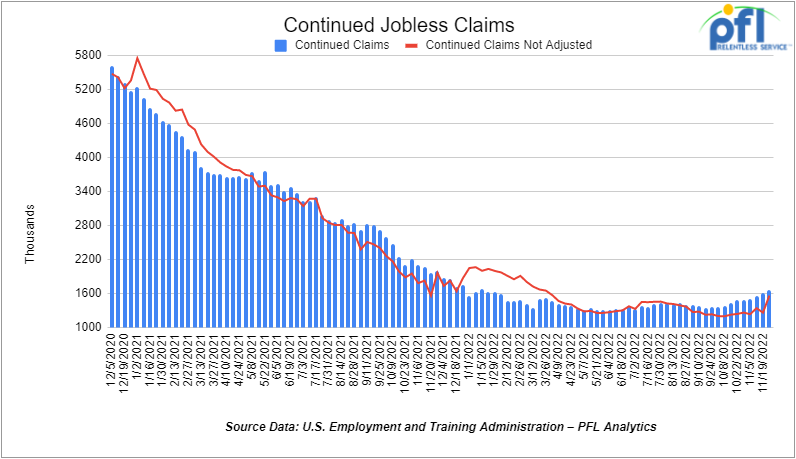
Stocks closed lower on Friday of last week and lower week over week
The DOW closed lower on Friday of last week, down -305.02 points (-0.9%), closing out the week at 33476.46, down -953.42 points week over week. The S&P 500 closed lower on Friday of last week, down -29.13 points (-0.73%), and closed out the week at 3,934.38, down -137.32 points week over week. The NASDAQ closed lower on Friday of last week, down -77.39 points (-0.68%), and closed the week at 11,004.62, down -456.88 points week over week.
In overnight trading, DOW futures traded lower and are expected to open at 33,550 this morning up +52 points.
Oil closed lower on Friday of last week, and lower week over week
WTI traded down -0.44 per barrel (-0.62%) to close at $71.02 per barrel on Friday of last week, down -$8.96 per barrel week over week. Brent traded down -US$0.05 per barrel (-0.4%) on Friday of last week, to close at US$76.10 per barrel, down -$9.47 per barrel week over week.
U.S. commercial crude oil inventories (excluding those in the Strategic Petroleum Reserve) decreased by 5.2 million barrels week over week. At 413.9 million barrels, U.S. crude oil inventories are 9% below the five-year average for this time of year.
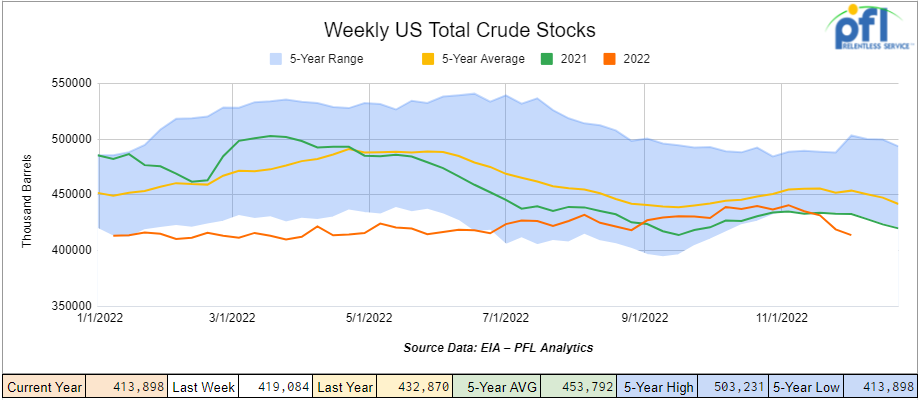
Total motor gasoline inventories increased by 5.3 million barrels week over week and are 3% below the five-year average for this time of year.
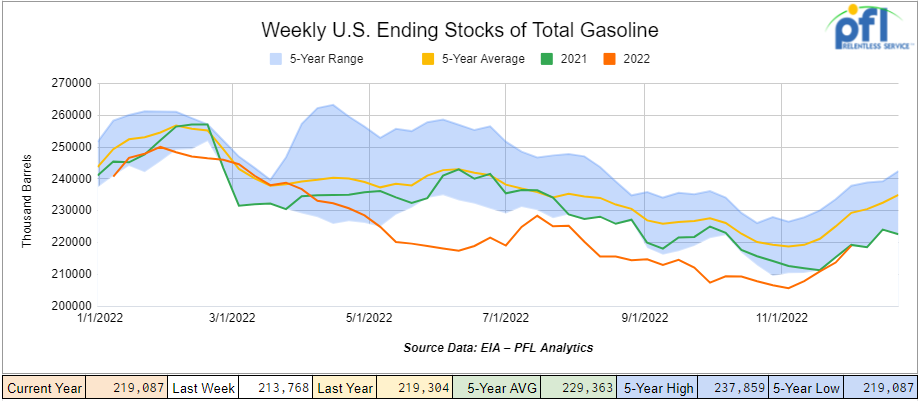
Distillate fuel inventories increased by 6.2 million barrels week over week and are 9% below the five year average for this time of year.
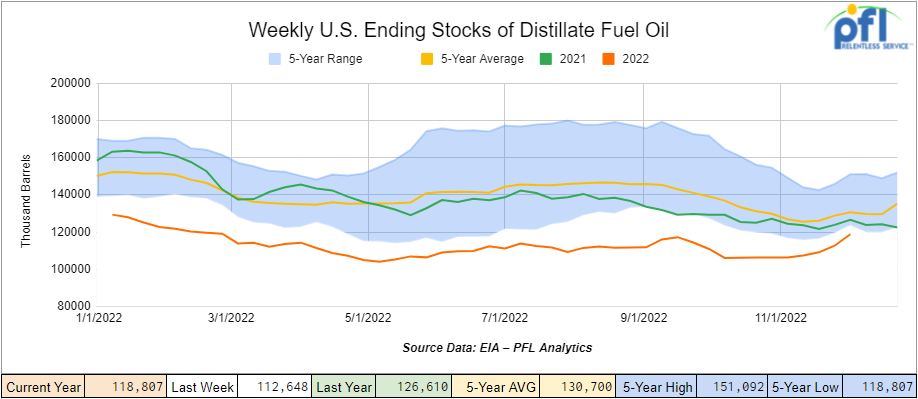
Propane/propylene inventories decreased by 1.0 million barrels week over week and are 14% above the five year average for this time of year
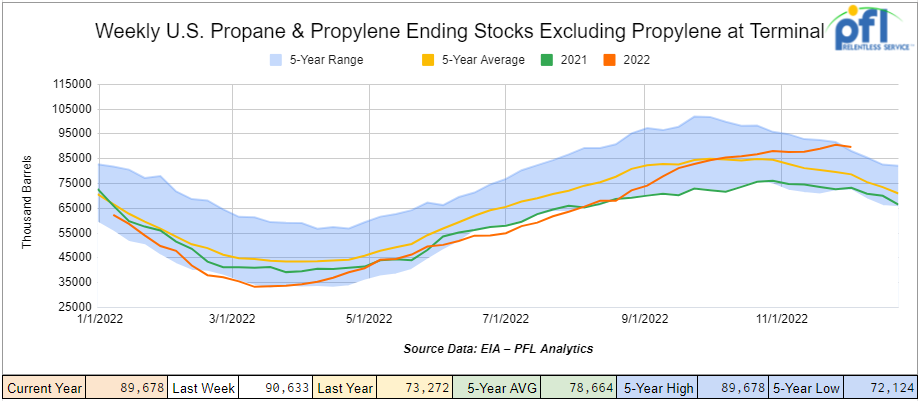
Propane prices continued to decline and lost 7 cents per gallon week over week closing at 76 cents per gallon down 26 cents per gallon year over year.

Overall, total commercial petroleum inventories increased by 5.9 million barrels week over week.
U.S. crude oil imports averaged 6.0 million barrels per day during the week ending December 2nd, 2022 a decrease of 24,000 barrels per day from the previous week. Over the past four weeks, crude oil imports averaged 6.2 million barrels per day, 4.1% less than the same four-week period last year. Total motor gasoline imports (including both finished gasoline and gasoline blending components) averaged 519,000 barrels per day, and distillate fuel imports averaged 372,000 barrels per day during the week ending December 2nd, 2022.
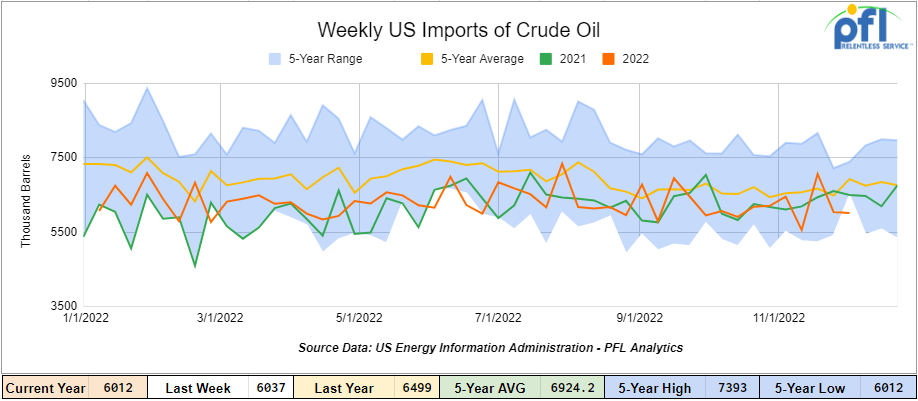
U.S. crude oil refinery inputs averaged 16.6 million barrels per day during the week ending December 2, 2022 which was 53,000 barrels per day less than the previous week’s average.
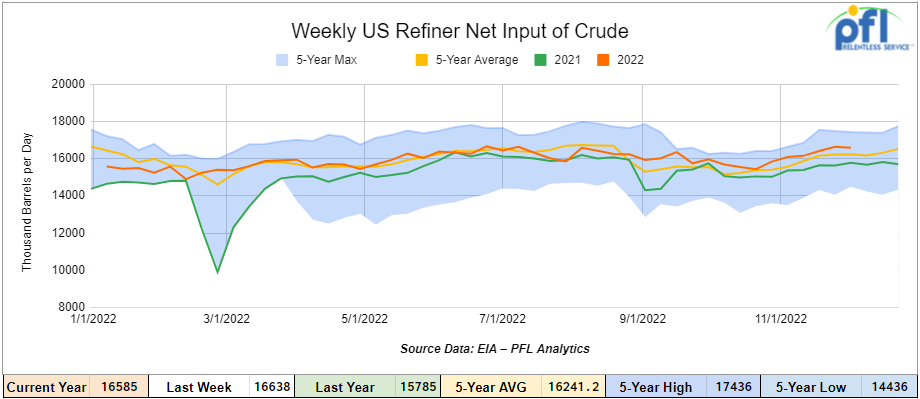
As of the writing of this report, WTI is poised to open at $70.43, down -$0.59 per barrel from Friday’s close.
North American Rail Traffic
Week Ending December 3rd, 2022.
Total North American weekly rail volumes were down (-5.46%) in week 48 compared with the same week last year. Total carloads for the week ending on December 3rd were 361,523, down (-4.25%) compared with the same week in 2021, while weekly intermodal volume was 311,911, down (-6.82%) compared to 2021. 8 of the AAR’s 11 major traffic categories posted year-over-year decreases with the most significant decrease coming from Chemicals (-20.76%). The largest increase was from Petroleum and Petroleum Products (+3.91%).
In the east, CSX’s total volumes were down (-5.23%), with the largest decrease coming from Chemicals (-12.80%) and the largest increase from Grain (+6.34%). NS’s volumes were down (-1.86%), with the largest decrease coming from Metallic Ores and Minerals (-7.53%) and the largest increases from Grain (+42.3%).
In the West, BN’s total volumes were down (-12.21%), with the largest decreases coming from Chemicals (-81.24%), and the largest increase coming from Other (+13.71%). UP’s total rail volumes were down (-3.31%) with the largest decrease coming from Metallic Ores and Metals (-17.76%) and the largest increase coming from Other (+9.58%).
In Canada, CN’s total rail volumes were up (+2.15%) with the largest decrease coming from Chemicals (-20.85%) and the largest increase coming from Motor Vehicles and Parts (+21.75%). CP’s total rail volumes were down (-6.16%) with the largest decreases coming from Intermodal Units (-33.37%) and the largest increase coming from Petroleum and Petroleum Products (+46.67%).
KCS’s total rail volumes were down (-1.62%) with the largest decrease coming from Motor Vehicles and Parts (-29.08%) and largest increase coming from Petroleum and Petroleum Products (+50.17%).
Source Data: AAR – PFL Analytics
Rig Count
North American rig count was up by +3 rig week over week. U.S. rig count was down by -4 rigs week-over-week and up by +204 rigs year over year. The U.S. currently has 780 active rigs. Canada’s rig count was up by +7 rig week-over-week, and up by +25 rigs year-over-year. Canada’s overall rig count is 202 active rigs. Overall, year over year, we are up +229 rigs collectively.
North American Rig Count Summary

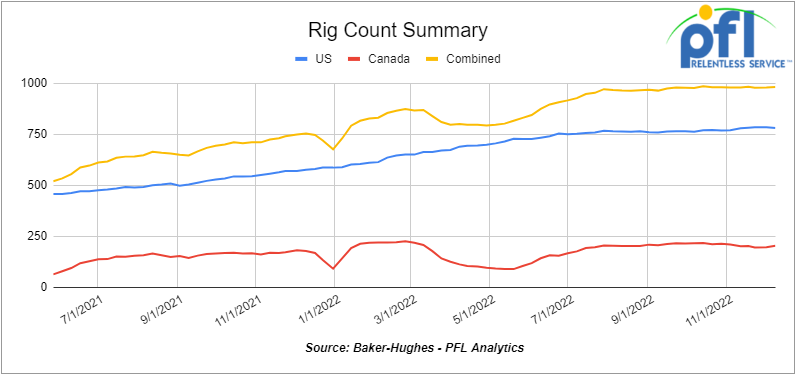
A few things we are keeping an eye on
We are watching Petroleum Carloads
The four-week rolling average of petroleum carloads carried on the six largest North American railroads rose to 24,659, from 24,290, which was a gain of 369 railcars week-over-week Canadian volumes were up; CP’s shipments increased by +8% week over week, and CN’s volumes were up 3% week over week. U.S. shipments were mixed. The UP had the largest percentage increase, up by +21.4%, and the CSX had the largest percentage decline and was down by 4.9%.
We are watching Keystone Pipeline Leak
The Keystone pipeline leaked 14,000 barrels of oil into creek in north-eastern Kansas (150 North West of Kansas City) last week is the largest for an onshore crude pipeline spill in more than nine years and by far the biggest in the history of the Keystone pipeline, according to federal data. Canada-based TC Energy estimated the spill on the Keystone system at about 14,000 barrels and said the affected pipeline segment had been “isolated” and the oil contained. It did not say how the spill occurred. After a drop in pressure on the pipeline that carries oil from Canada to the Texas Gulf coast, the company said it shut down its Keystone system on Wednesday of last week. The US Environmental Protection Agency said there were no known effects yet on drinking water wells or the public in connection with last week’s spill. Market effects in Canada were immediate crushing basis to -35 dollars per barrel initially. It is unclear at this point how long the pipeline will be shuttered for. Stay tuned to PFL for further details.
Some Key Economic Indicators
Purchasing Managers Index (“PMI”) – The PMI (which covers manufacturing) and the Services PMI (covering services) are both from the Institute for Supply Management. They are based on surveys of supply managers around the country. The surveys track the direction of changes in business activity. An index reading above 50% indicates expansion; below 50% means contraction. The more above or below 50, the faster the pace of change.
The PMI was down month over month at 49% in November versus 50.2% in October This is the lowest level since May of 2020 and the first time the index has printed below 50%. Seven straight months of softening demand has meant manufacturers have largely been working off backlog. (The backlog of orders subcomponent of the PMI was 40% in November, down from around 65% a year ago when,
In contrast to the PMI, the ISM’s Services PMI — which covers services instead of manufacturing — was 56.5% in November, up from 54.4% in October. Of the 18 services industries that comprise the Services PMI, 13 reported growth in November.

Industrial Output and Capacity Utilization Total U.S. industrial output rose a preliminary and seasonally adjusted 0.1% in October 2022 from September 2022, according the Federal Reserve. In October 2022, it was 105.1.
Manufacturing output was up a preliminary 0.1% in October, the fourth straight month over month gain. Manufacturing accounts for 75% of total output. At 102.9 in October, the manufacturing index was its highest since July 2008.
In recent months, motor vehicles, nonmetallic minerals (which includes industrial sand and much else), and petroleum refineries have seen above-average output gains. On the other hand, the past few months have not been kind in terms of output of railroad rolling stock, lumber products, iron and steel products, and plastics and agricultural chemicals due to higher natural gas feedstock prices.
Overall capacity utilization fell to a preliminary and seasonally adjusted 79.9% in October from 80.1% in September. It’s the lowest total capacity utilization has been in four months. Manufacturing capacity utilization in October was a preliminary 79.5%, the same as in September.
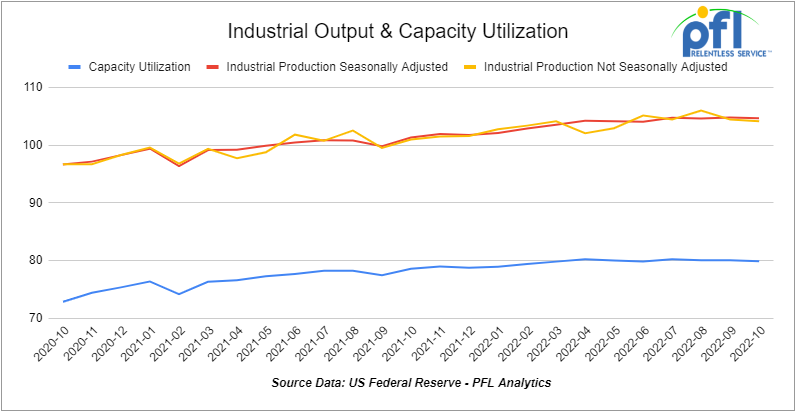
The Bureau of Labor Statistics reported on November 4th, that a preliminary 263,000 net new jobs were created in November That’s down slightly from October’s 284,000 and September’s 269,000. The unemployment rate was unchanged in November at 3.7%.
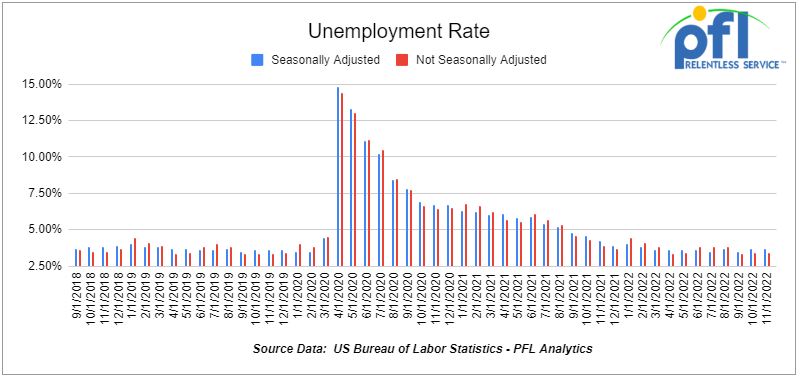
Consumer Confidence was 100.2 in November, down from 102.2 in October 2022 and down from 111.9 in November 2021.
The University of Michigan’s Index of Consumer Sentiment also fell in November, to 56.8 from 59.9 in October. The economist in chart of the Michigan index said, “Along with the ongoing impact of inflation, consumer attitudes have also been weighed down by rising borrowing costs, declining asset values, and weakening labor market expectations.
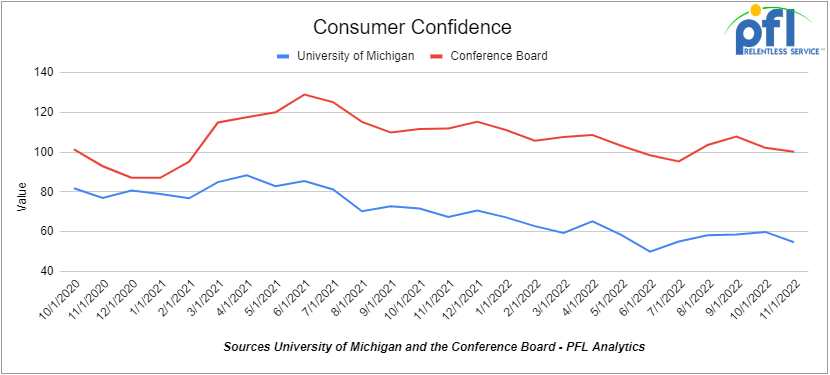
Total consumer spending in October 2022 was 7.9% higher than in October 2021, according to Bureau of Economic Analysis data released December 1. That’s slightly faster than the rate of inflation over that period and is a sign consumers overall still have the wherewithal to spend at a high level. Spending on goods was up 7.1% over last year; spending on services was up 8.4%.
Spending on goods in October was 1.4% higher than in September; services, 0.5%; and total spending 0.8% (the most in four months).
Adjusted for inflation, total consumer spending in October 2022 was 1.8% higher than in October 2021 (the smallest year-over-year gain since February 2021) and was 0.5% higher than in September 2022 (the biggest month-to-month gain since January 2022).
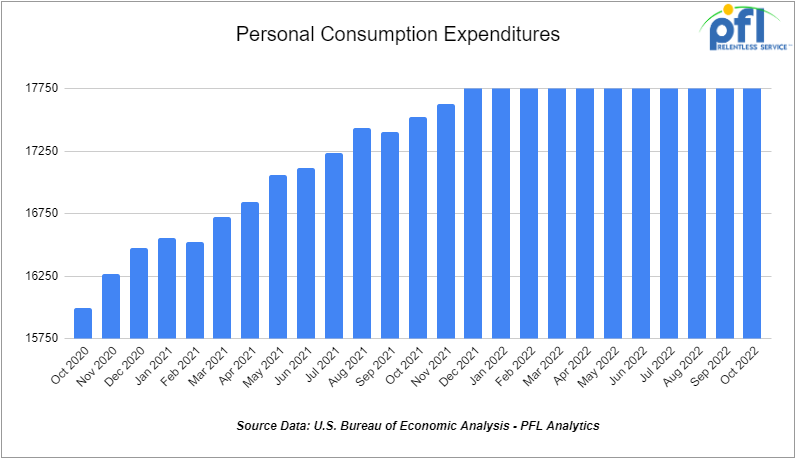
We have been extremely busy at PFL with return-on-lease programs involving rail car storage instead of returning cars to a shop. A quick turnaround is what we all want and need. Railcar storage in general has been extremely active. Please call PFL now at 239-390-2885 if you are looking for rail car storage, want to troubleshoot a return on lease scenario, or have storage availability. Whether you are a car owner, lessor or lessee, or even a class 1 that wants to help out a customer we are here to “help you help your customer!”
Leasing and Subleasing has been brisk as economic activity picks up. Inquiries have continued to be brisk and strong Call PFL Today for all your rail car needs 239-390-2885
PFL is seeking:
- 2-4, 28k Tanks for purchase in Minnesota off of the BNSF for use in Biodiesel.
- 8, 23.5 tanks CSX in the east for polyacryamide for 2 years plus
- 35, 5400-6300 Covered hoppers for lease off the BN needed in Iowa for 3-5 Years.
- 5, 20K unlined tanks needed in Texas for 2 years BNSF – more needed by year end
- 100-200, 340W Pressure cars for a 12 month term for propane. Can take in various locations, needed ASAP
- 10 Propane cars needed in North Dakota for Winter Lease. Needed ASAP.
- 50 6350 covered hoppers in the midwest with most class ones for up to 5 years for DDG
- Up to 40 5500 Covered Gons 286 unlined CSX/NS preferred but will consider other
- 4 Lined tanks for glycerin to run from Arkansas to Georgia 1-3 years
- 30 boxcars on UP or CP for 3 years to run from TX to Edmonton – negotiable
- 100, 2480 CU-FT Ag Gons needed in Texas off of the UP for 1-3 Years.
- Various Hoppers 286 GRL 4200-7000 CU FT in several locations negotiable
- 300 5800 Covered hoppers needed for plastic – 5-year lease – negotiable
- 50, 5800cuft or larger Covered Hopper for use in DDG needed in the Midwest for 3-4 years. Immediate need.
- 10-20 Covered hopper grain cars in the midwest 5200-5500 2-3 years
- 100 Moulton Sulfur cars for purchase – any location – negotiable
- 50 Ag Gons 2500-2800cuft 286k GRL in the east for 5 years negotiable
- 100 15K Tanks 286 for Molten Sulfur in the Northeast CSX/NS for 6 months negotiable
- 100, 5800 Covered Hoppers 286 can be West or East for Plastic 3-5 years
- 50, 6500+ cu-ft Mill Gon or Open Top Hopper for wood chips in the Southeast for 5 Years.
- 20, 19,000 Gal Stainless cars in Louisiana UP for nitric acid 1-3 years – Oct negotiable
- 10, 6,300CF or greater covered hoppers are needed in the Midwest.
PFL is offering:
- 20, CPC 1232s last in Gasoline. On the UP in Texas, Short term.
- 50, 30K 117Js Last in Diesel. Free move on the UP or BN. Can return Dirty
- 120, 30K 117Rs Last in Diesel. Free move on the UP or BN. Can return Dirty
- 25 117Rs for sublease dirty to dirty service BN/UP – negotiable
- 25, 31.8K CPC 1232 last in Crude in New Mexico. Dirty to Dirty.
- 200 Clean C/I 25.5K 117J in Texas. Brand New Cars!
- 150 DOT 111s last in ethanol in the Midwest with free move.
- Up to 500 sand cars for sale or lease at various locations and class ones – Great Price!
- 150 117R’s 31.8 clean for lease in Texas KCS – for sale or lease – negotiable
- 31.8K Tank Cars last in Diesel. Dirty to dirty in Texas
- 200 117Js 29K in the Midwest. Lined and brand new- lease negotiable
- 100 117Rs dirty last in Gasoline in Texas for lease Negotiable
- Various Hoppers for lease 263 and 268 multiple locations negotiable
- 300W pressure cars located in various locations.
- 200 117Js 29K OK and TX Clean and brand new – Lined- lease negotiable
- Various tank cars for lease with dirty to dirty service including, nitric acid, gasoline, diesel, crude oil, Lease terms negotiable, clean service also available in various tanks and locations including Rs 111s, and Js.
Call PFL today to discuss your needs and our availability and market reach. Whether you are looking to lease cars, lease out cars, buy cars or sell cars call PFL today at 239-390-2885
PFL offers turn-key solutions to maximize your profitability. Our goal is to provide a win/win scenario for all and we can handle virtually all of your railcar needs. Whether it’s loaded storage, empty storage, subleasing or leasing excess cars, filling orders for cars wanted, mobile railcar cleaning, blasting, mobile railcar repair, or scrapping at strategic partner sites, PFL will do its best to assist you. PFL also assists fleets and lessors with leases and sales and offers Total Fleet Evaluation Services. We will analyze your current leases, storage, and company objectives to draw up a plan of action. We will save Lessor and Lessee the headache and aggravation of navigating through this rapidly changing landscape.
PFL IS READY TO CLEAN CARS TODAY ON A MOBILE BASIS WE ARE CURRENTLY IN EAST TEXAS
Live Railcar Markets
| CAT | Type | Capacity | GRL | QTY | LOC | Class | Prev. Use | Clean | Offer | Note |
|---|
